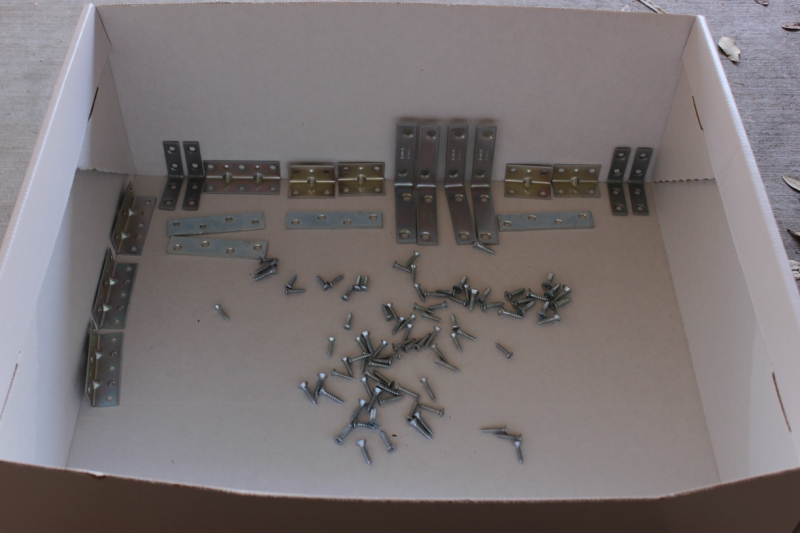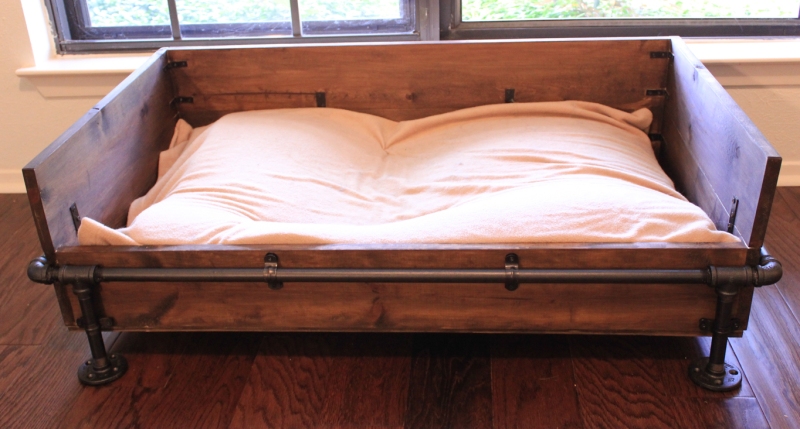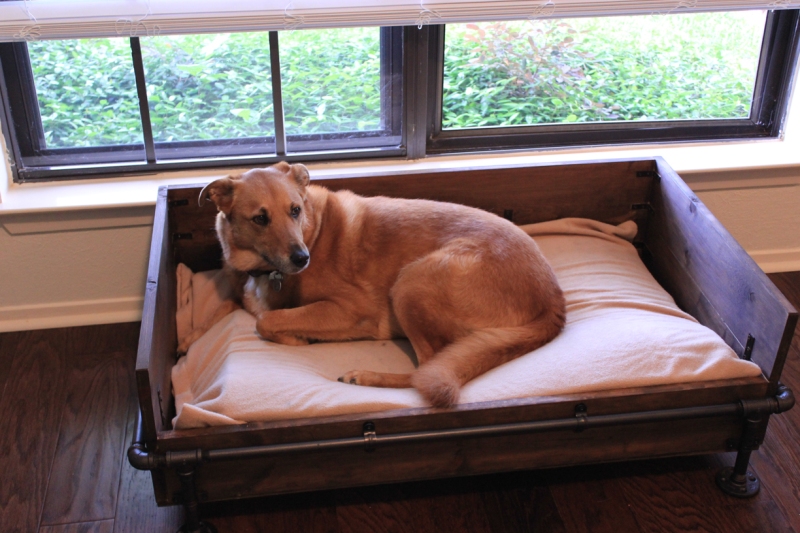What exactly is a rustic industrial dog bed? Heck if I know. I just know that the furniture theme for my sitting and dining rooms is metal + dark or reclaimed wood. The sitting room has a low window that our dog will lay in front of, on one of her pillow style beds, and stare at the outside world. I wanted to make a dog bed that fit in with the furniture in that part of the house and that wouldn’t get pushed around by the pets or the roomba. After seeing a tutorial on a keen life where they made a set of shelves from some metal plumbing pipe and wood, I knew I found the perfect materials for my dog bed. It only took me a few months to finally get all the stars to align so I could finish it, and I’ve yet to make a new cushion for it, but at least the old dog bed cushion fits reasonably well. A preview of the finished product with my dog model:
After I got the idea in my head, I picked up 6″ pine boards, an assortment of brackets, spray paint, and the metal pipe and fittings necessary to make a rectangular frame for the dog bed. After bringing home the metal pipe and fittings, my husband and I assembled the rectangular frame with short legs. Because the fittings all have to screw together, and we were trying to screw a rectangle of parts together, we were constantly tightening one corner while loosening another corner. Eventually we got all the fittings to loosely screw together with the plan to glue the joints later for a firmer hold. After creating the rectangle, I measured the inside of it to determine what size wood boards I needed.

After refreshing my memory on exactly how to use the table saw, I got to work cutting my pine boards to size.

I put all the screws and brackets in a shallow box and spray painted them from all angles with Rustoleum Oil Rubbed Bronze spray paint. It took multiple coats to get all of the angles done so that no shiny silver metal was left showing.

After measuring the same length from the end of both boards, and using the brackets as a guide to mark my holes, I drilled pilot holes and then screwed in the screws.

After the sides were assembled, I attached the bottom with L shaped brackets that had 2 or 3 screws in a horizontal line on each side.
I used Timbersoy wood stain, color walnut, from EcoProCrete that was left over from a previous project. The stain goes on thin, so I used a sponge applicator and applied multiple coats until it was as dark as I wanted. To seal the wood, I used Miss Mustard Seed Hemp Oil Wood Finish, also purchased for a different project. The oil is applied by rubbing it in with an old cloth. I used two coats for now. It gives the wood just a bit of sheen, which worked well for the look I was trying to create.
After that was done, I put the metal frame around the bed and used that as a guide to help make sure the short legs were straight before I glued everything in place. I used gorilla glue and a toothpick to try to force some glue into each joint. Gorilla glue expands as it dries so after I was done I had to use a box cutter to remove the excess glue from the top of the frame where it would easily be seen. It took me three tries to get all of the joints adequately glued. The next step was to spray paint the frame.
After adding the gaskets to the bottom of the metal frame, it was time to attach the frame to the wood box. I used some scrap wood to set the wood box on so that it would not be flush with the floor while I attached the brackets.
I used brackets that are meant to go with this pipe to attach it to the wood box. The only trouble was that the pipe doesn’t sit flush with the box because of the T and corner junctions. I improvised by using some large nuts and washers as standoffs for the brackets.

Spray painted brackets, with the washers and nuts used as standoffs to attach the wood bed to the metal frame.
I also used brackets on the four short legs in case the glue didn’t completely hold in places. I used sticky rubber furniture pads on the bottom of the frame feet to keep the floor from getting scratched.
Finally, completion! A few photos of the sitting room so you can see how the new bed fits in:

The relatively new couch, coffee table, and side table with the ancient Ikea chair. Still need to replace that chair. Oh, and the dog.














How did u screw the last pipe
LikeLike
It was a combo of screwing in one side all the way, then the other about halfway (which unscrewed the first side halfway). Then I glued all the joints for stability. It’s still together and gets plenty of use!
LikeLike
Did you clean your pipe? If so what did you use? Love this bed!
LikeLike
I just used water and a scrub brush, let it dry and then spray painted. Thanks!
LikeLike
Laura, do you by any chance have the plans you used for this project? Are those 1×6’s you used for the frame? Also, what thickness plywood did you use for the bottom? Any info would be great.
LikeLike
Hi Ryan – I didn’t really have plans, other than to figure out what size my dog’s other bed was and I used those dimensions as a starting point.
I did use 1×6’s for the sides, stacking 2 of them on the 3 sides, and only 1 on the 4th side. The bottom is 3/4″ plywood. Some of this wood we already had, which is why I chose it.
LikeLike
Hi Laura,
Where did you get the metal piping and fittings? Do you have wooden feet or anything attached to the wooden box underneath for added support or is the metal frame enough support as is? I want to have my husband build something similar to yours, but possibly large enough to fit 2 beds for 2 dogs, as we are getting a new puppy… only problem is, is that they are Golden Retrievers and well, rather large! 😉
Thank you for the help!
LikeLike
Hi Lindsey,
I think I got the pipe and fittings at Lowe’s, but I’m pretty sure Home Depot carries it as well. I didn’t need any extra support for the wooden box since the plywood was pretty thick, and my dog is only 50 lbs. If you make a much larger bed, you probably want to add an extra support bar somehow. I hope it turns well!
LikeLike